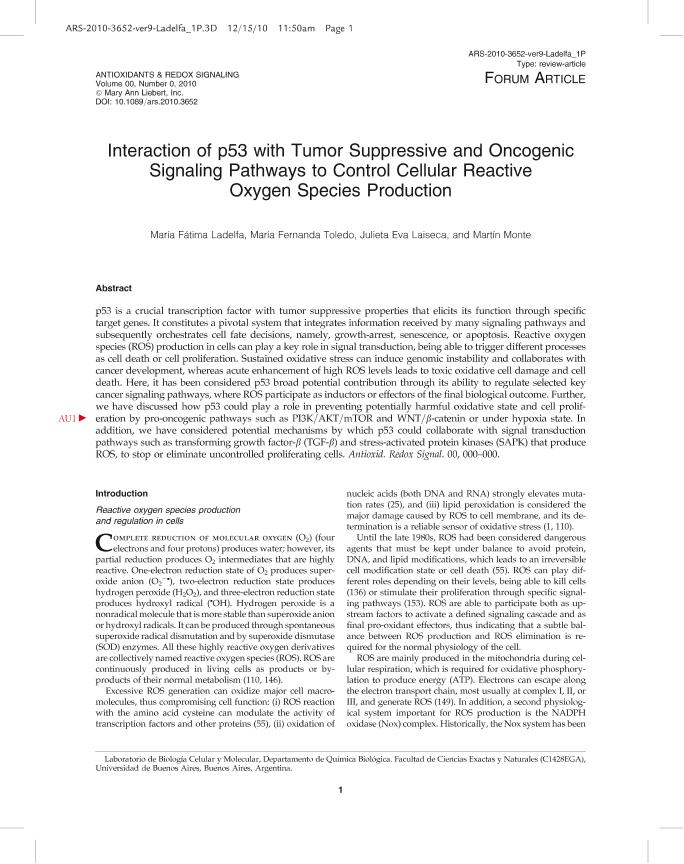Artículo
Interaction of p53 with tumor suppressive and oncogenic signaling pathways to control cellular reactive oxygen species production
Fecha de publicación:
09/2011
Editorial:
Mary Ann Liebert
Revista:
Antioxidants & Redox Signaling
ISSN:
1523-0864
Idioma:
Inglés
Tipo de recurso:
Artículo publicado
Clasificación temática:
Resumen
p53 is a crucial transcription factor with tumor suppressive properties that elicits its function through specific target genes. It constitutes a pivotal system that integrates information received by many signaling pathways and subsequently orchestrates cell fate decisions, namely, growth-arrest, senescence, or apoptosis. Reactive oxygen species (ROS) production in cells can play a key role in signal transduction, being able to trigger different processes as cell death or cell proliferation. Sustained oxidative stress can induce genomic instability and collaborates with cancer development, whereas acute enhancement of high ROS levels leads to toxic oxidative cell damage and cell death. Here, it has been considered p53 broad potential contribution through its ability to regulate selected key cancer signaling pathways, where ROS participate as inductors or effectors of the final biological outcome. Further, we have discussed how p53 could play a role in preventing potentially harmful oxidative state and cell proliferation by pro-oncogenic pathways such as PI3K/AKT/mTOR and WNT/β-catenin or under hypoxia state. In addition, we have considered potential mechanisms by which p53 could collaborate with signal transduction pathways such as transforming growth factor-β (TGF-β) and stress-activated protein kinases (SAPK) that produce ROS, to stop or eliminate uncontrolled proliferating cells. © 2011 Mary Ann Liebert, Inc.
Palabras clave:
P53
,
Ros
,
Signalling
Archivos asociados
Licencia
Identificadores
Colecciones
Articulos(IQUIBICEN)
Articulos de INSTITUTO DE QUIMICA BIOLOGICA DE LA FACULTAD DE CS. EXACTAS Y NATURALES
Articulos de INSTITUTO DE QUIMICA BIOLOGICA DE LA FACULTAD DE CS. EXACTAS Y NATURALES
Articulos(OCA CIUDAD UNIVERSITARIA)
Articulos de OFICINA DE COORDINACION ADMINISTRATIVA CIUDAD UNIVERSITARIA
Articulos de OFICINA DE COORDINACION ADMINISTRATIVA CIUDAD UNIVERSITARIA
Citación
Ladelfa, Maria Fatima; Toledo, Maria Fernanda; Laiseca, Julieta Eva; Monte, Martin; Interaction of p53 with tumor suppressive and oncogenic signaling pathways to control cellular reactive oxygen species production; Mary Ann Liebert; Antioxidants & Redox Signaling; 15; 6; 9-2011; 1749-1761
Compartir
Altmétricas




